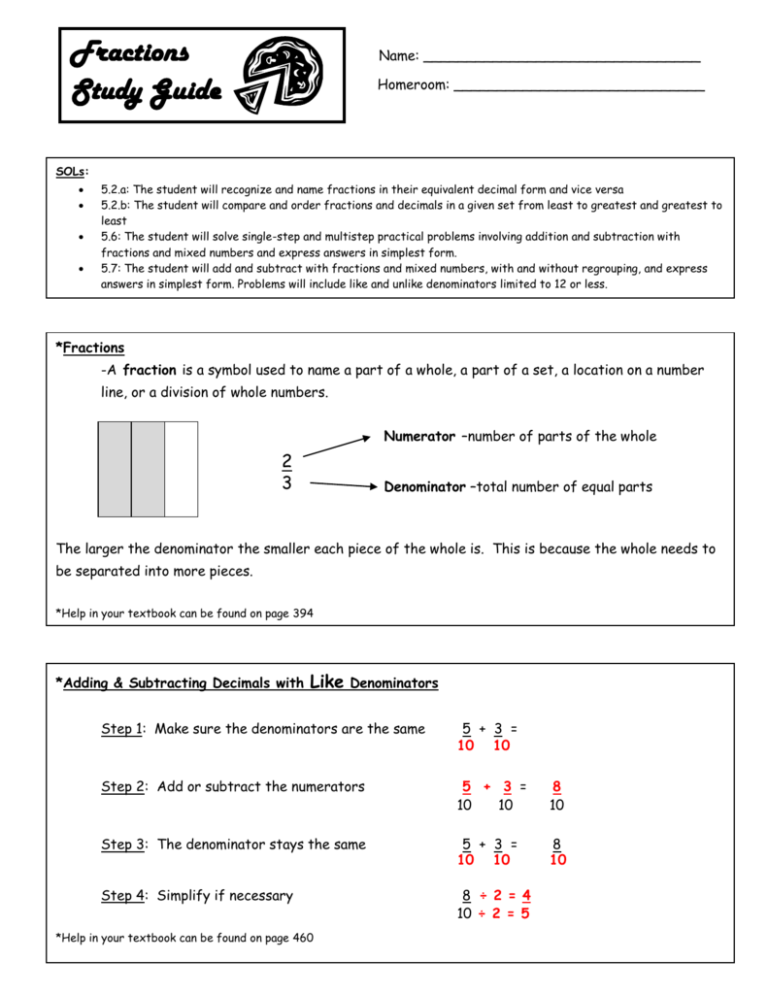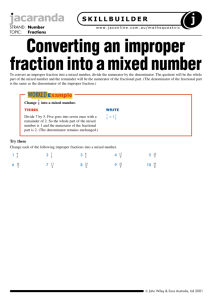Fractions Study Guide
advertisement

Fractions Study Guide Name: ________________________________ Homeroom: _____________________________ SOLs: 5.2.a: The student will recognize and name fractions in their equivalent decimal form and vice versa 5.2.b: The student will compare and order fractions and decimals in a given set from least to greatest and greatest to least 5.6: The student will solve single-step and multistep practical problems involving addition and subtraction with fractions and mixed numbers and express answers in simplest form. 5.7: The student will add and subtract with fractions and mixed numbers, with and without regrouping, and express answers in simplest form. Problems will include like and unlike denominators limited to 12 or less. *Fractions -A fraction is a symbol used to name a part of a whole, a part of a set, a location on a number line, or a division of whole numbers. Numerator –number of parts of the whole 2 3 Denominator –total number of equal parts The larger the denominator the smaller each piece of the whole is. This is because the whole needs to be separated into more pieces. *Help in your textbook can be found on page 394 *Adding & Subtracting Decimals with Like Denominators Step 1: Make sure the denominators are the same 5 + 3 = 10 10 Step 2: Add or subtract the numerators 5 + 3 = 10 10 8 10 Step 3: The denominator stays the same 5 + 3 = 10 10 8 10 Step 4: Simplify if necessary 8 ÷ 2 = 4 10 ÷ 2 = 5 *Help in your textbook can be found on page 460 *Adding & Subtracting Decimals with Unlike Denominators Step 1: Find an equivalent fraction for both fractions, so that they both have the same denominator 4 + 1 = 8 6 a) find the LCM of the denominators 8: 8, 16, 24, 32 6: 6, 12, 18, 24, 30 6 b) find the equivalent fraction 4 x 3 = 12 8 3 24 1x4=4 6 4 24 4 Step 2: Once the denominators are the same, add or subtract the numerators 12 + 4 = 16 24 24 Step 3: The denominator stays the same 12 + 4 = 16 24 24 24 Step 4: Simplify if necessary 16 ÷ 8 = 2 24 ÷ 8 = 3 *Help in your textbook can be found on page 462-469 * Improper Fractions & Mixed Numbers *An improper fraction has a numerator greater than or equal to its denominator. *A mixed number has a whole number and a fraction. 1 12 8 5 6 *Any number over itself = 1 whole: 1 = 1 *Help in your textbook can be found on page 460 *Any number over one = itself: 4 1 1 =4 10 10 10 1 =1 = 10 *Converting Mixed Numbers & Improper Fractions *Use division to convert an improper fraction into a mixed number. 1 Step 1: Divide the numerator by the denominator 12 8 8 12 -8 4 Step 2: Write the remainder as a fraction (over the denominator) 4 8 Step 3: Write your answer as a mixed number and simplify if necessary 1 4 ÷ 2 = 8 ÷ 2 = *Use multiplication to convert a mixed number into an improper fraction. Step 1: Multiply the whole number by the denominator. 33 3 x 4 = 12 4 Step 2: Add your answer to the numerator 12 + 3 = 15 Step 3: Put the new numerator over the old denominator. 15 4 *Help can be found in your textbook on page 400 * Comparing & Ordering Fractions Step 1: Find a common denominator (LCM) 2 7 5 3 12 8 Step 2: Find equivalent fractions using the common denominator 3 3, 6, 9, 12, 16, 28, 21, 24 2 x 8 = 16 7 x 2 = 14 5 x 3 = 15 12 12, 24, 36 3 x 8 = 24 12 x 2 = 24 8 x 3 = 24 8 8, 16, 24 16 7 5 Step 3: Compare/Order 14 < 24, *Help in your textbook can be found on page 420 15 24, < 24 so < 12, 2 < 3, 8 1 2 4 * Converting Fractions to Decimals 0. 8 Step 1: Divide the numerator by the denominator (Make sure to put in your decimal point) 4 5 4.0 5 - 40 0 Step 2: Rewrite your answer as a decimal 0.8 *Help in your textbook can be found on page 426-427. *Converting Decimals to Fractions Step 1: Say the decimal in word form. (Word names for decimals will help you write decimals as fractions.) 0.8 is said “eight tenths” = 8 10 Step 2: Simplify if necessary. 8 ÷ 2 = 4 10 ÷ 2 = 5 *Help in your textbook can be found on page 426-427. *Multiplying Fractions Step 1: Multiply the Numerators 4 x 3 = 12 5 8 Step 2: Multiply the Denominators 4 3 = 12 5 x 8 = 40 Step 2: Simplify if necessary. 12 ÷ 4 = 3 40 ÷ 4 = 10 *Help in your textbook can be found on page 490-491. *Dividing Fractions Step 1: Write the inverse of the second fraction (flip) 4 ÷ 2 5 8 Step 2: Multiply the numerators 4 x 8 = 32 5 2 Step 3: Multiply the denominators Step 2: Simplify if necessary. 4 5 8 2 4 8 = 32 5 x 2 = 10 32 ÷ 2 = 16 10 ÷ 2 = 5 *Help in your textbook can be found on page 502 -503. or 1 35 Designed by Tara VanPatten






